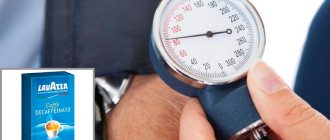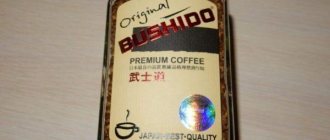Varieties of coffee 3 in 1
The 3 in 1 packaged drink can be divided into several types:
- the ingredients include coffee beans;
- chicory is used instead of natural coffee;
- The main component is barley, chestnuts or acorns.
The products also differ in taste. They may contain a hint of hazelnut, cinnamon, caramel, coconut, etc.
The products are produced by different manufacturers. Among the most popular of them are:
- Jacobs. The brand is extremely popular. Produces good quality instant coffee;
- Nescafe. Arabica beans are used in production. Due to this, the drink is characterized by a pleasant taste and rich aroma;
- MacCoffe. The company gained popularity back in the nineties of the last century;
- G7. It has excellent taste, but due to its high cost it is not in great demand;
- GoldenEagle. The products of this manufacturer were the first to appear on the Russian market. There are several varieties of coffee available, varying in strength.
Preparation and composition of products
The best coffee beans and first-class sugar are used for preparation.
To create McCoffee, only the highest quality raw materials and products are used. Coffee beans, which are the basis for the preparation of each type, are grown in Ethiopia, Brazil, Central and South America. A blend of only the most whole Arabica beans is selected, which are lightly roasted, therefore retaining their naturalness and wonderful aroma. Sugar is used only from Malaysia, and cream is imported from Holland.
Initially, the production of poppy coffee was launched in Singapore, and from there it spread throughout the world.
In 2006, an additional manufacturing plant was opened in the Moscow region. And in 2012, another factory was launched in Ukraine.
The MacCoffee brand has repeatedly become a sponsor of events. For example, in 2005, this product sponsored the World Figure Skating Championships, and in 2020, the European Championships in the same sport. In 2020, MacCoffee was the first sponsor of the World Cup of Hockey.
How to choose 3 in 1 coffee: tips for buyers
When you stop at a display case with coffee sticks, don’t rush to grab the cheapest one, don’t be fooled by the bright packaging and provocative inscriptions “Promotion! +20% free." Spend a few minutes looking closely at each variety.
- Inspect the packaging. It should be intact, not frayed, and the paint should not remain on your fingers. If the paint wears off from the heat of your hands, then most likely you are looking at a counterfeit. If the packaging is even slightly damaged, it means that moisture from the air has already gotten inside. The powder could become damp, and this leads to its rapid deterioration.
- Compare prices. If a bag of coffee costs much less than others of the same type, there is a reason to refuse the purchase. Coffee is the most expensive component of the mixture. A low price may mean that there is no coffee in the product.
- It is advisable to choose bags with notches - they are easier to open without the use of cutting devices.
- Classic sticks that open in the center when broken are also convenient.
- Try different brands. Even if all the previous conditions are met, the buyer may not like the taste. After all, each manufacturer prepares this drink according to its own recipe. The drink may seem too sweet, too bitter, even too strong. Therefore, it is worth buying several bags and choosing the right one among them: with a strong, persistent aroma, pleasant taste, warming, invigorating.
- Pay attention to the composition: whether there is coffee among the ingredients, where it is placed (if it is in the last place, it means there is a minimum amount of coffee powder in the serving). Choose products with the least amount of additives - stabilizers, emulsifiers, dyes, sweeteners, flavor enhancers. The minimal amount of sugar is another plus of this drink.
Study the composition. Coffee should be at the top of the list.
Freeze-dried coffee
Recently, this particular species has begun to be produced in ever larger quantities. Its popularity is explained by the fact that it is made from high-quality Arabica beans, which contain a small amount of caffeine. This product is created by freezing the coffee mass at a low temperature and further crushing it into small pieces. This method is quite expensive and time-consuming, but it preserves the coffee taste and aroma. Keep in mind that the price of this type of coffee is higher than others. Therefore, do not look for cheap options so as not to end up with a fake.
A brief excursion into history
Coffee appeared on our tables quite a long time ago, and today this drink is considered one of the most popular in the world. There are many different varieties, but mocha and arabica are still in great demand.
Doctors keep talking about the dangers of coffee for the human body. This is especially true for instant drinks. But not each of us has the opportunity to make coffee in a Turk or a coffee machine.
As they say, demand creates supply. At the dawn of the last century, manufacturers came up with instant coffee. It’s inconvenient to carry the jar everywhere, and you need to take care of the sugar. The next step was the production of a portioned drink combined with granulated sugar.
And here, lovers of an invigorating drink with the addition of cream or milk were left deprived. Agree, it’s inconvenient to take all the ingredients with you on a trip or on a picnic, but a bag with the inviting inscription “3 in 1” is just what you need.
It is not known for certain when exactly such a drink appeared, but immediately the miracle sachets began to enjoy resounding success
Origin story
At the beginning of the twentieth century, instant coffee began to be produced, which immediately became widespread.
The soluble option significantly saved time, because the powder did not need to be cooked using a special technology. This type began to be produced on a production scale and now a large assortment of instant products is presented on store shelves. But carrying a jar of powder with you to work was not very convenient, and manufacturers decided to start producing portioned sachets. However, many people prefer the drink with sugar, so they decided to add sugar along with the powder. The next improvement was the addition of milk powder and cream.
Thus, from one bag you get a sweet coffee drink with cream. Manufacturers offer 3-in-1 options with various flavors to satisfy the desires of every customer. The dangers of coffee are three in one and its benefits are of little interest to many consumers. It’s enough for them that it’s very convenient - they can take the bags to work, on trips, out of town.
Benefit or harm
No one doubts the convenience of 3-in-1 bags. Fill it with hot water and you're done. At work, on a hike, and finally in the army—portioned bags of coffee with sugar and cream have found their place and their fans everywhere.
According to experts, it won’t be a big problem if you sometimes drink packaged coffee instead of natural coffee. Of course, it contains a lot of sugar, contains trans-isomer fatty acids (in vegetable cream) and other substances that are not very useful for humans.
But a high-quality semi-finished product, consumed in small quantities, will not harm your health. And you can find good quality portioned coffee in stores, there is no doubt about it. It is enough to get acquainted with the materials of specialized magazines or websites to be convinced: there are manufacturers whose products receive high marks from experts.
If you drink this drink occasionally, no harm will be done to the body. True, the sublimate will not bring any benefit either. Positive changes can only be observed if the composition contains natural grains. Thanks to their presence, you will be able to get a boost of energy.
Three-in-one coffee will cause harm if consumed systematically. This may cause the following problems:
- increase in body weight. Due to high sugar content;
- disruption of the nervous system, gastrointestinal tract;
- removal of calcium from the body;
- heart problems.
Separately, it should be said about the dangers of this sublimate during pregnancy. It is not advisable for pregnant women to drink coffee at all.
Caffeine can cause miscarriage and provoke abnormalities in the development of the child. Expectant mothers should completely avoid the 3-in-1 drink. It contains a lot of chemicals and a lot of sugar. If you really can’t give up coffee, it is recommended to give preference to a natural product.
It is possible to reduce the negative impact of a coffee drink. In this case, you should adhere to the following recommendations:
- add a little natural milk to the composition. Thanks to this, it will be possible to compensate for the lack of calcium;
- Avoid using sublimate on an empty stomach. It is best to drink it half an hour after eating;
- after each cup of drink, drink at least a glass of plain water;
- do not abuse coffee products. It is strictly forbidden to drink it too often.
Calorie count and caffeine content
The manufacturer’s desire to reduce the cost of the product and eliminate the unpleasant taste of low-quality raw materials leads to the addition of a huge amount of sugar to the soluble powder. In this regard, the number of calories in a seemingly harmless bag increases significantly, so the energy value of 100 g of dry powder is 358.25 kcal, which is equivalent to a piece of smoked sausage of the same weight.
The calorie content of one sachet is very high due to the large amount of sugar
At the same time, the carbohydrate content is also at a high level of 69.84 g, which is about 26% of the daily requirement required by a person; this figure relative to the “empty” product is amazing, especially in relation to fats (10.35 g) and proteins (2.33 g ).
In instant coffee with sugar and cream, caffeine does not exceed 0.5% of the total mass. And this is in the best case, because a low-quality product may not contain it at all. The invigorating effect of such a drink is questionable, since strong black tea contains caffeine from 2 to 4%.
Composition of packaged coffee with cream: do we know what we are drinking?
Unfortunately, natural milk powder or cream has a limited shelf life. Therefore, to believe that such components are in sticks, the shelf life of which is measured in months, or even years, is at least naive. They are replaced with vegetable cream, which consists of:
- coconut or palm oil;
- milk protein;
- glucose syrup;
- acidity regulator;
- emulsifiers, stabilizers, dyes, flavor enhancers.
As you can see, instead of natural cream, the packaged drink uses a component with a rather complex chemical composition.
Now – directly about coffee. It is the most expensive ingredient in the 3-in-1 mixture, so it is not surprising that manufacturers are trying to save money on this component. This means that the packaging may contain a small amount of low-grade coffee, as well as chicory, chopped nuts, chestnuts or barley grains. Such a marketing ploy does not harm the body, but such a drink has nothing to do with coffee, even if the packaging indicates the opposite.
As for sugar, everything is simple: the more there is, the more obvious the manufacturer’s attempt to mask the imperfect taste of coffee and cream looks. Therefore, instant drinks from three-in-one packages often have an overly sweet, even cloying taste.
The remaining additives - caramel, rum, cognac, nutmeg, coconut and others - also have a very indirect relationship to their natural ancestors.
As you can see, the component composition cannot be called useful and surprising.
On a note! Unfortunately, unfair competition is rampant, and a number of manufacturers do not add even 13% coffee to their bags.
The right 3-in-1 drink must contain coffee, and this ingredient always comes first. As for cream, all instant sachets, regardless of brand, without exception, contain cream of plant origin. This must be coconut or palm oil. In general, the composition of the so-called cream is very complex and such components have nothing in common with a natural product.
Now let's talk about coffee. As already mentioned, some manufacturers, in order to save money, do not add instant coffee to 3-in-1 bags at all. Don’t be surprised if, under the guise of coffee, you are offered chicory, chopped chestnuts or nut kernels.
Important! Such drinks in bags contain a large amount of granulated sugar. It is with the help of a sweetener that manufacturers manage to mask the imperfect taste of coffee and cream. Accordingly, the calorie content of such a drink will be prohibitively high.
Often, all sorts of flavor enhancers are added to instant coffee drinks, for example, caramel, nutmeg, vanilla, rum, etc. If you believe the researchers who tested the contents of such bags in the laboratory, these additives have nothing in common with the true ancestors. This is another marketing ploy.
Important! If you drink 3 in 1 coffee extremely rarely and in small quantities, then you will not cause any harm to your health. Experts recommend pampering yourself with freshly brewed ground coffee.
What is vegetable cream
Vegetable cream is made by combining several ingredients. Coconut or palm oil is often used, which is diluted with water. Artificial flavors are added to the mixture to give it a milky taste. Stabilizers, which are also included in cream, are necessary to increase the shelf life of the product.
Cream comes in two consistencies: liquid and dry. To produce instant coffee, cream is used in powder form. Liquid cream is used for confectionery purposes, for sauces, ice cream, and cream soups.
The label of a 3-in-1 product should indicate that it contains vegetable cream.
Calorie content
100 grams of product contain:
- Proteins – 2.35 grams.
- Carbohydrates – 69.72 grams.
- Fats – 10.40 grams.
The calorie content of the product is 358.25 kcal.
Since the three-in-one product contains a lot of sugar, it is considered high in calories.
Due to the high sugar content, 3 in 1 coffee is very high in calories
Why pregnant women shouldn’t have 3-in-1 coffee
Expectant mothers are sensitive to the choice of products so as not to harm the baby’s health. Experts strongly recommend avoiding drinking coffee during pregnancy, since excessive caffeine consumption can cause early miscarriages and also provoke abnormalities in fetal development. As for the three-in-one product, expectant mothers should completely avoid its consumption due to the chemicals in the composition and the high sugar content. If you have an irresistible desire, you can drink only good quality natural coffee.
Are these drinks healthy?
It is better not to consume such packaged products every day. Of course, if you drink in moderation, there will be no harm.
And if regularly, then some problems will arise in the form of:
- Dependencies.
- Heart disease, because it contains transgenic fats.
- Excess weight.
- Diabetes mellitus.
- Oncology.
This coffee can be used to prepare a variety of baked goods. It is also better for expectant mothers to avoid consuming such drinks so as not to harm the baby.
There are benefits too.
- The soluble product can be stored for a long time.
- It is quick and easy to prepare.
- It has a pleasant taste and aroma.
Read: Esmeralda coffee brand from Brazil
How it's done
In the list of ingredients for 3-in-1 coffee, you can find about a dozen components. However, most of this list can be combined under one name - “vegetable cream”.
The invention of a cream substitute made it possible to solve a number of problems. You can't put real milk or cream into a bag of coffee powder. Natural dry cream does not last as long as we would like. But “vegetable” ones are very convenient. The product received this name because it has the color, taste and aroma of cream, but the main component is vegetable fat. The shelf life of dry vegetable cream is increased several times compared to natural cream.
The composition of vegetable cream includes:
- vegetable fats (coconut or palm oil);
- glucose syrup;
- milk protein;
- acidity regulator;
- stabilizers, emulsifiers (substances that provide the desired consistency of the product);
- flavorings and dyes (giving creamy color and taste).
Often manufacturers do not indicate all these components, and then the composition of 3-in-1 coffee looks like this:
- natural instant coffee;
- sugar;
- vegetable cream.
This is the best case scenario. In a low-quality product, coffee comes last. And sometimes the most important component may not be in it at all! These coffee drinks are usually made from chicory, chestnuts, barley or nuts. If the manufacturer honestly informs the buyer about this, then there is nothing criminal. These drinks are great for people who are contraindicated for caffeine. But if on the front side of the package the buyer sees the inscription “Natural instant coffee”, and on the back in the smallest letters - “chicory”, then the result is a deception.
Cost of coffee bags, where to buy, who produces
Coffee in drip bags
Its first producers were the Japanese. They were inspired by the pour-over method of brewing, popular in the Land of the Rising Sun. Other manufacturers borrowed the idea from the Japanese. In Russia, drip coffee is rapidly gaining popularity, and its own manufacturers are appearing.
- Coffee Yata . Several types of coffee are sold under this brand in filter bags. The assortment includes single-varietal varieties Cuba Turquino and Colombia Supremo, as well as blends from different parts of the world. The manufacturer of the brand is a Russian company. The cost of a package of 10 sachets of 8 grams is 250 rubles. That is, 100 grams of such coffee costs approximately 315 rubles, one serving costs 25 rubles.
- Blendy. It sells mainly blends of good Arabica coffee. The brand is of Japanese origin and is manufactured by the large concern AGF. The products are appreciated by domestic coffee lovers. The cost of a package of 8 sachets of 7 grams is 250 rubles. The cost of 100 grams of coffee is 445 rubles, and one cup is about 31 rubles.
- Brand . Another Russian manufacturer. He currently sells only one variety of coffee, Brazil Santos, at a cost of 350 rubles for 10 bags weighing 8 grams. 100 grams will cost 440 rubles, and one serving will cost 35 rubles.
- Coffesso . Trademark of the Russian manufacturer May. Sells Italian roasted Arabica beans. A package of 8 bags will cost from 230 rubles, that is, one serving – from 28 rubles.
Ground coffee in bags for one cup
Well-known brands are experimenting with such packaging, but, apparently, the format is not very popular.
- The Madeo brand offers individual servings for one cup at prices ranging from 320 to 550 rubles per pack of 10 pieces, which gives the cost per serving from 32 to 55 rubles.
- Lavazzo , a well-known European brand, some time ago also made an attempt to produce natural coffee for one cup. The cost was about 400 rubles for 10 sachets, but recently offers of this product have disappeared even from specialized stores.
Coffee in closed filter bags
They are produced by little-known and completely unknown manufacturers in our country, which, frankly speaking, do not inspire much confidence.
- Bestcoffee from Latvia offers bags at a price of 300 rubles per pack of 10 pieces. The origin of the grains is not specified. One bag contains 8 grams of ground powder.
- PHUONG Vy is a Vietnamese brand. Offers 100% Arabica under the name "Superb Morning". A package of 16 sachets costs 295 rubles. Brewing takes place for 3-5 minutes in hot water.
Even the mentioned manufacturers are difficult to find on supermarket shelves; they sell their products mainly through online stores.
It seems that drip coffee is winning the competitive race for now. It is preferred by manufacturers, buyers, and retail chains.











